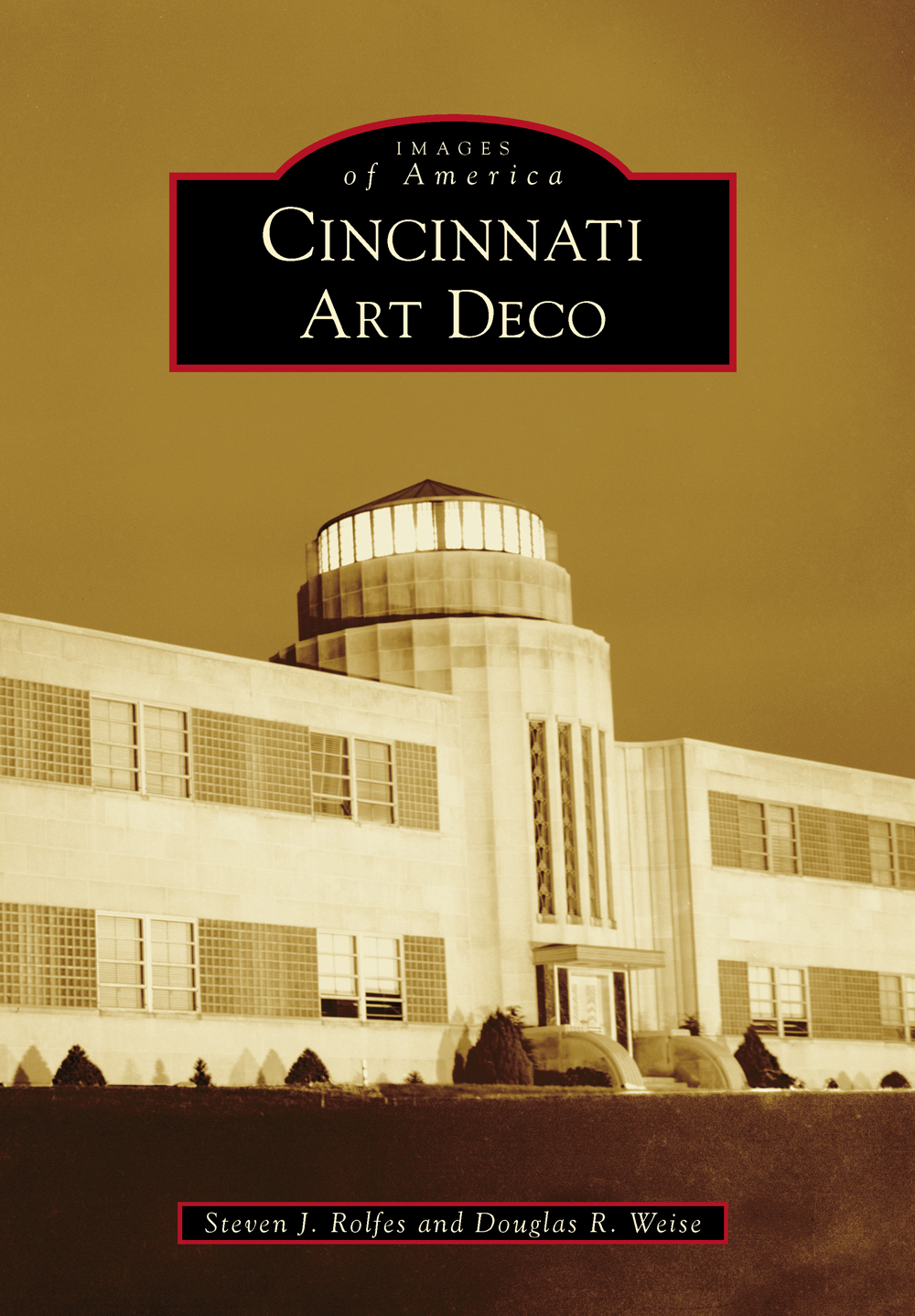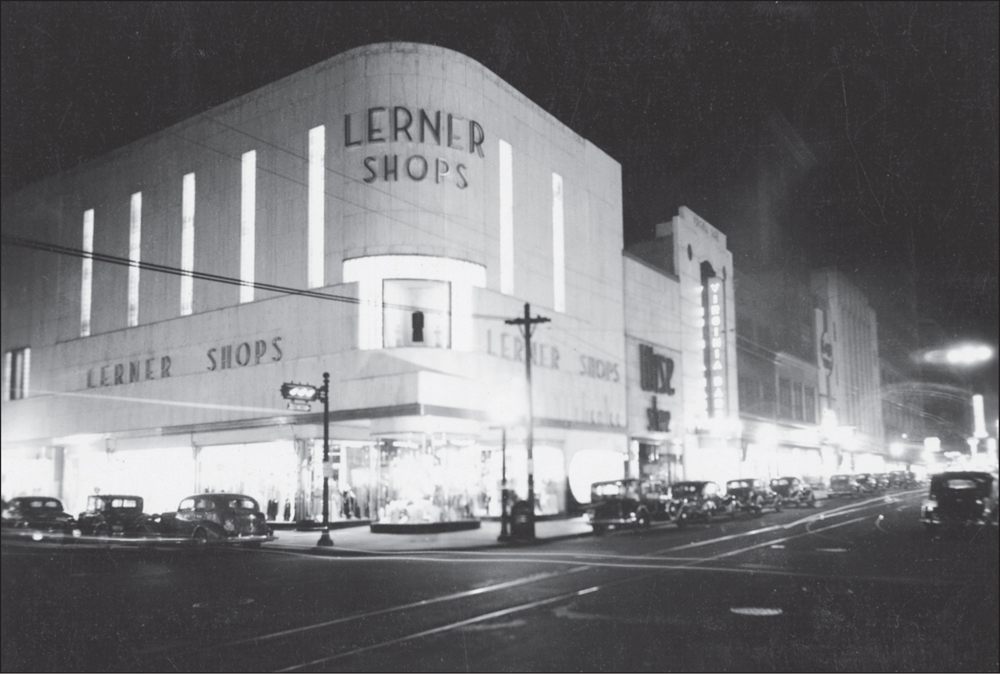
IMAGES
of America
CINCINNATI
ART DECO

Art Deco buildings were usually streamlined, modern, and often somewhat daring in their design. Lerner Shops seems to protrude towards the viewer like a knife, as seen in this vintage nighttime photograph. (Courtesy of the Ohio Historical Society SA1039AV_B02F14_015_1.)
ON THE COVER: Looking at this Art Deco masterpiece, it is hard to imagine that architect John Henri Deeken made his reputation by designing stately, English-style mansions. In 1937, he was commissioned by the Coca-Cola Bottling Company to design its Cincinnati facility. The result was this astonishing work, captured here by the famed Cincinnati photographer Paul Briol. (Courtesy of the Cincinnati Museum Center, Cincinnati Historical Society Library.)
IMAGES
of America
CINCINNATI
ART DECO
Steven J. Rolfes and Douglas R. Weise

Copyright 2014 by Steven J. Rolfes and Douglas R. Weise
ISBN 978-1-4671-1200-0
Ebook ISBN 9781439646120
Published by Arcadia Publishing
Charleston, South Carolina
Library of Congress Control Number: 2013953315
For all general information, please contact Arcadia Publishing:
Telephone 843-853-2070
Fax 843-853-0044
E-mail
For customer service and orders:
Toll-Free 1-888-313-2665
Visit us on the Internet at www.arcadiapublishing.com
To Judy and Isabelle Weise and all Cincinnatians who preceded us, great and small, who made this city so remarkable; also, to the memory of James Rolfes (19982013).
CONTENTS
ACKNOWLEDGMENTS
This book would not have been possible without the help of several very supportive people.
We would like to thank everyone associated with the Public Library of Cincinnati and Hamilton County, the Greater Cincinnati Memory Project, the Southwest Ohio and Neighboring Libraries, and the Ohio Historical Society. We would also like to thank the Kenton County Public Library and the Cincinnati History Library and Archives.
Thanks go to Sharyn Speckman, president of the North College Hill Historical Society; Rebecca Strand Johnson, the Pogue family, the people at the Delhi Historical Society, and Penny Huber and David Huser of the Mt. Healthy Historical Society. Thanks also go to Sandy Nagel at North Presbyterian Church and Karen F. Maier, vice president of marketing at Frischs Restaurants.
We especially thank Phil Lind for graciously sharing several outstanding photographs from his collection. Thanks and appreciation go to Michel Sheer, Bob Louis, and Peter Goldstein at the Hilton Netherland Plaza, and to Douglass W. McDonald and Elizabeth Pierce at the Cincinnati Museum Center at Union Terminal. Many thanks go to John Williams and the great folks at the 20th Century Theater.
Thanks go to our acquisitions editors at Arcadia, Mary Margaret Schley for getting this book off the ground and Jesse Darland for seeing it through to completion.
We thank our families for all of their help and support, especially Jordan Rolfes of Beagle Rampant Productions, for the beautiful photographs and hours of technical support.
As always, we thank our Lord for his many blessings.
INTRODUCTION
If you wish to understand history, look at economics. If you wish to understand a society, look at its art.
It was Robert Bonfils who created the famous poster for the 1925 Exposition internationale des arts dcoratifs et industriels modernes. The poster, modern and daring, is in just two colors. It depicts a barefoot nymph running from right to left. Just behind her is a stylized gazelle. The nymph and the gazelle are at the same spot, apparently running at the same speed. Had this poster been made two decades earlier, it no doubt would have been filled with flowers and cherubs, the woman depicted in realistic hues. Rather than racing with a gazelle, she probably would have been standing majestically. Now, in this new age, she was a surprisingly simple drawing, with very few features to denote her. Her stature was sleek, modern, and most importantly, in motion.
Art Deco, a term that was not invented until the 1960s, was not born in the great French exposition, but, rather, amidst the pain and bloodshed in the trenches that scarred Europe seven years earlier. When an average, insignificant man, Gavrilo Princip, gunned down the Archduke Ferdinand, in Sarajevo in 1914, it set off a disastrous chain of events. These aftermaths, brought on by a commoner, utterly and completely transformed the entire world and the course of history. When the smoke cleared and the bodies were buried, the world became a very different place. Princip had murdered not just one nobleman, but the entire dynasty of the Hapsburgs, the Hohenzollerns, the Romanovseven the ancient House of Osman, which ruled the Ottoman Dynasty (although the halife remained as a figurehead, and would not be formally exiled until 1924)were gone. In place of these outdated monarchies came a new worldthe world of the common man. With the exception of Russia, these nations charged into the new century, ready to grab history by the collar and take it to places where it had never been before. Now, they had a new art form to symbolize this rise of the common man, all of which was given form on a poster for a worlds fair.
Art and architecture experts constantly argue and subdivide the genre. For example, the category known as Art Moderne is a smoothly streamlined and Modernist style often limited in, or devoid of, decorations. As Germany entered the wild time of the Weimar Republic, Walter Gropius helped to create the school of architecture known as Bauhaus, combining modernism with an emphasis on function over form. Other forms of Art Deco, such as the French style, feature a great deal of ornamentation, often combined with more traditional styles.
Art Deco was more than just architecture. It influenced traditional art, such as the paintings of Tamara de Lempicka and Hildreth Meiere, the sculptures of Demetre Chiparus, Antoine Bourdelle, and Willard Stone, and many other artists and genres. From glassworks to symphonies to architecture, this modern style captured the spirit of the timesrestless and defiant, ready to grab hold of the future and ride it like a charging bull. Thus it bears to reason that much of Art Deco is streamlined and, like the character in that original poster, in motion.
One of the most enjoyable places to look at Art Deco is in film. Perhaps the definitive deco moment in the cinema is that stunning scene of a suicidal Fred Astaire and Ginger Rogers dancing on a Modernist rooftop to Lets Face the Music and Dance in the 1936 film Follow the Fleet. Both of the characters are ready to commit suicide after losing their money: Astaire, from gambling and who, along with Rogers, is about to jump off of the roofas so many Wall Street executives had done. Instead, they defy poverty (i.e., the Great Depression) and dance. Of course, the classic film scene, the one which most truly captures the spirit of Art Deco, is in Merian Coopers 1933 King Kong. Here, the ultimate individual, Kong, has climbed to the pinnacle of the greatest Art Deco building of all time, the newly erected Empire State Building. Despite the biplanes shooting at him, the great individual strikes back, swatting helplessly as he is defiant to the oppression of technology. The ape dies not in a cage, but as a free creature, defiant to the end. Of course, we all know it was beauty that killed the beast.
Next page













